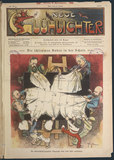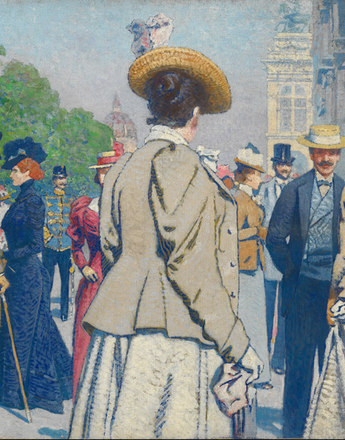-

Theodor Zasche: The Emperor's birthday: The children of Archduchess Marie Valerie present their congratulations, drawing, 1908
Copyright: Schloß Schönbrunn Kultur-und Betriebsges.m.b.H./Fotograf: Alexander E. Koller
-

“The wicked boys at school”, caricature from Neue Glühlichter, issue of 19 January 1899
Copyright: ÖNB Bildarchiv und Grafiksammlung
Partner: Austrian National Library
Around the turn of the century the Austro-Hungarian Monarchy enjoyed a glorious flowering in the arts, scholarship and science. At the same time, however, the country was shaken by apparently insoluble social and national conflicts. Under a dazzlingly brilliant surface the Habsburg imperium was struggling with a profound crisis.
By the beginning of the twentieth century the Habsburg political system had become rigidified through its traditional policy of ‘muddling through’, which was marked by a constant preference for compromise and a reluctance to forge concrete solutions to its most serious political, economic and social problems.
The most urgent issue was the question of the nationalities, which in a state with so many ethnic groups was a particularly explosive problem. Amongst the various nationalisms, one that posed a particular threat to the Danube monarchy’s power of cohesion was German nationalism. In addition, Magyar separatism was on the increase, so that Austria-Hungary was under serious threat of disintegrating.
After a long period of emancipation the smaller nationalities were soon also making demands for greater participation in the political system. Vain attempts to solve the problems on the part of constantly changing governments had the opposite effect and led to veritable state crises, with the dramatic escalation of ethnic conflicts sometimes resulting in states of affairs bordering on civil war. The state found that there was less and less it could do to mitigate the general malaise.
The Monarchy also found that it had less and less room to manoeuvre on the foreign front. Ever since the conclusion of the Dual Alliance in 1878 Germany had been by far its most important partner. The Austrians were perfectly aware of the problems inherent in their increasing dependence on a vastly more powerful ally but they clung to the Alliance for want of any viable alternatives.
Austria-Hungary’s close relationship with Germany did in fact have a stabilizing effect at home, because the German Empire created by Bismarck had expanded to its final borders and was not contemplating any expansion into Austrian territories. The alliance with Germany was also important for the German nationals within the Habsburg Monarchy, as its dependence on the strong German partner was a guarantee of their privileged position in the Monarchy as a whole. Although the German nationalists nurtured the pan-Germanist dream of the German-speaking areas of the Habsburg Empire being incorporated into the Reich, this project was rejected by Bismarck, who had the strongest possible interest in the survival of a vigorous and resilient Danube Monarchy.
Translation: Peter John Nicholson
Hanisch, Ernst: Der lange Schatten des Staates. Österreichische Gesellschaftsgeschichte im 20. Jahrhundert [Österreichische Geschichte 1890–1990, hrsg. von Herwig Wolfram], Wien 2005
Rauchensteiner, Manfried: Der Erste Weltkrieg und das Ende der Habsburgermonarchie 1914–1918, Wien u. a. 2013
Rumpler, Helmut: Eine Chance für Mitteleuropa. Bürgerliche Emanzipation und Staatsverfall in der Habsburgermonarchie [Österreichische Geschichte 1804–1914, hrsg. von Herwig Wolfram], Wien 2005
Traum und Wirklichkeit. Wien 1870–1930. Katalog der 93. Sonderausstellung des Historischen Museums der Stadt Wien 1985, Wien 1985
Das Zeitalter Kaiser Franz Josephs – 2. Teil: 1880–1916. Glanz und Elend. Katalog der Niederösterreichischen Landesausstellung auf Schloss Grafenegg 1987, Wien 1987




